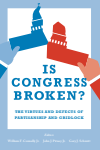Abstract
Making Congress Work, Again, Within the Constitutional System
Congress for many years has ranked low in public esteemjoining journalists, bankers, and union leaders at the bottom of polls. And in recent years there's been good reason for the public disregard, with the rise of hyper-partisanship and the increasing inability of Congress to carry out its required duties, such as passing spending bills on time and conducting responsible oversight of the executive branch.
Congress seems so dysfunctional that many observers have all but thrown up their hands in despair, suggesting that an apparently broken U.S. political system might need to be replaced.
Now, some of the country's foremost experts on Congress are reminding us that tough hyper-partisan conflict always has been a hallmark of the constitutional system. Going back to the nation's early decades, Congress has experienced periods of division and turmoil. But even in those periods Congress has been able to engage in serious deliberation, prevent ill-considered proposals from becoming lawand, over time, help develop a deeper, more lasting national consensus.
The ten chapters in this volume focus on how Congress in the twenty-first century can once again fulfill its proper functions of representation, deliberation, legislation, and oversight. The authors offer a series of practical reforms that would maintain, rather than replace, the constitutional separation of powers that has served the nation well for more than 200 years.
Schlagworte
Partisanship Polarization William F. Connelly Jr. U.S. Congress Legislative Branch Dysfunction Congress John Pitney Jr. Is Congress Broken? Gary J. Schmitt Broken Government Gridlock- Kapitel Ausklappen | EinklappenSeiten
- i–viii Preface i–viii
- 1–10 Introduction 1–10
- 241–242 Contributors 241–242
- 243–258 Index 243–258

